Protection for Employees
Pyloto allows the reliable protection of insufficiently protected working areas within automated guided vehicle systems.
Our blocking device Pyloto allows the reliable protection of areas which are insufficiently protected in particular during maintenance work, e.g. at load transfer stations, or not covered by suitable personnel detection means.
Lockable
Pyloto is lockable and inhibits the accidental or unauthorized removal of the cone by the solid and usual lockout-tagout procedure.
Our blocking device Pyloto allows performing the usual lockout-tagout procedure (Pyloto-procedure) whereby Pyloto is secured with a personal padlock against accidental or unauthorized removal. The Pyloto-procedure is very easy and safe to perform for every person involved.
Performance Level
Pyloto uses the performance level of the personnel detection means that are installed in the automated guided vehicle.
Our blocking device Pyloto uses the performance level of the electro-sensitive protective equipment, whereby the reliable stop of the automated guided vehicle is ensured. Blocking areas through the radio link of the guidance control system does not comply with the required performance level D and is not secured against accidental or unauthorized restart.
Defined Positions
Pyloto is anchored in defined positions whereby the cone reliably stands in the correct position.
Our blocking device Pyloto avoids that the cone is placed at an incorrect position. With unmistakable positioning of the cone the reliable stop of the automated guided vehicle is ensured.
Pyloto im Video erklärt
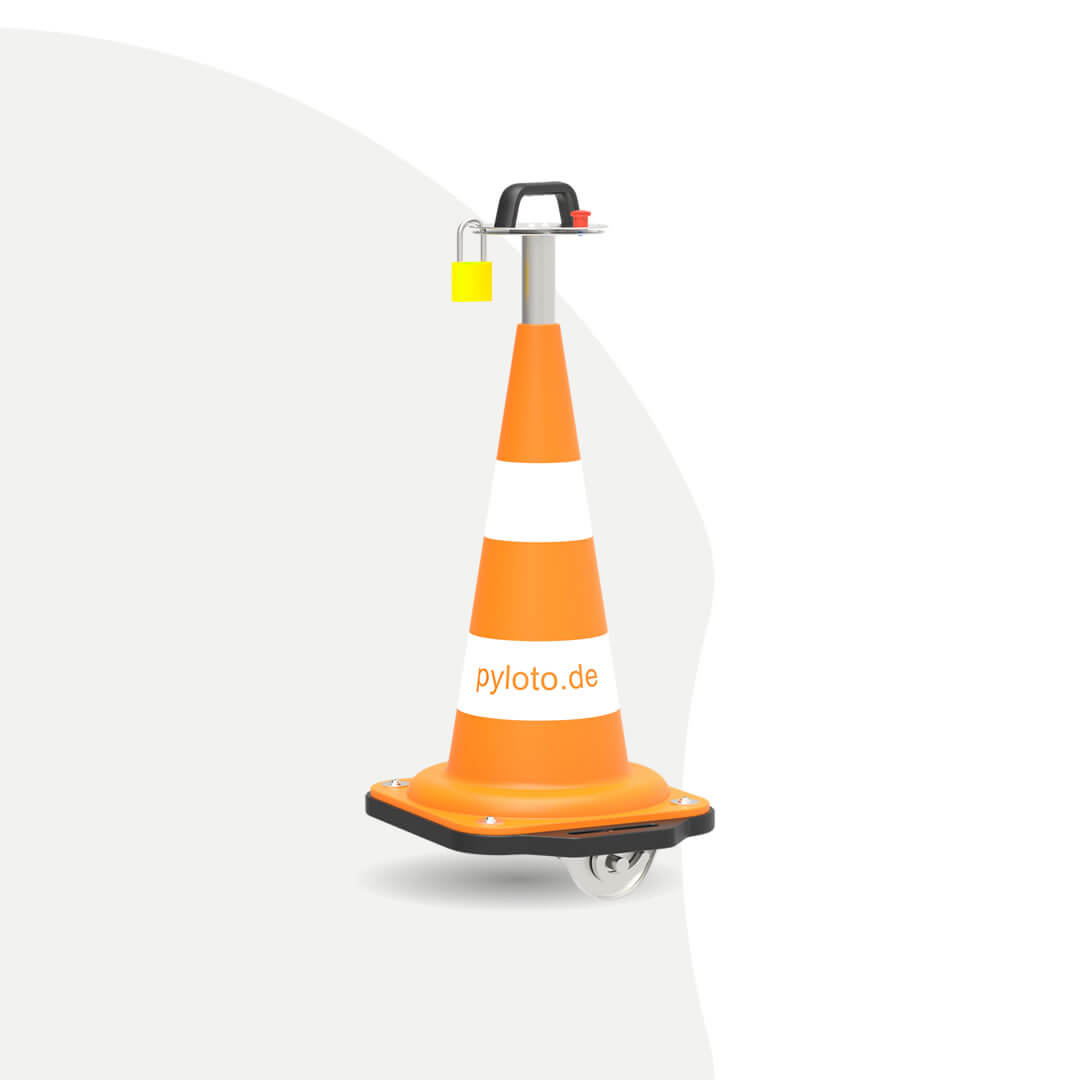
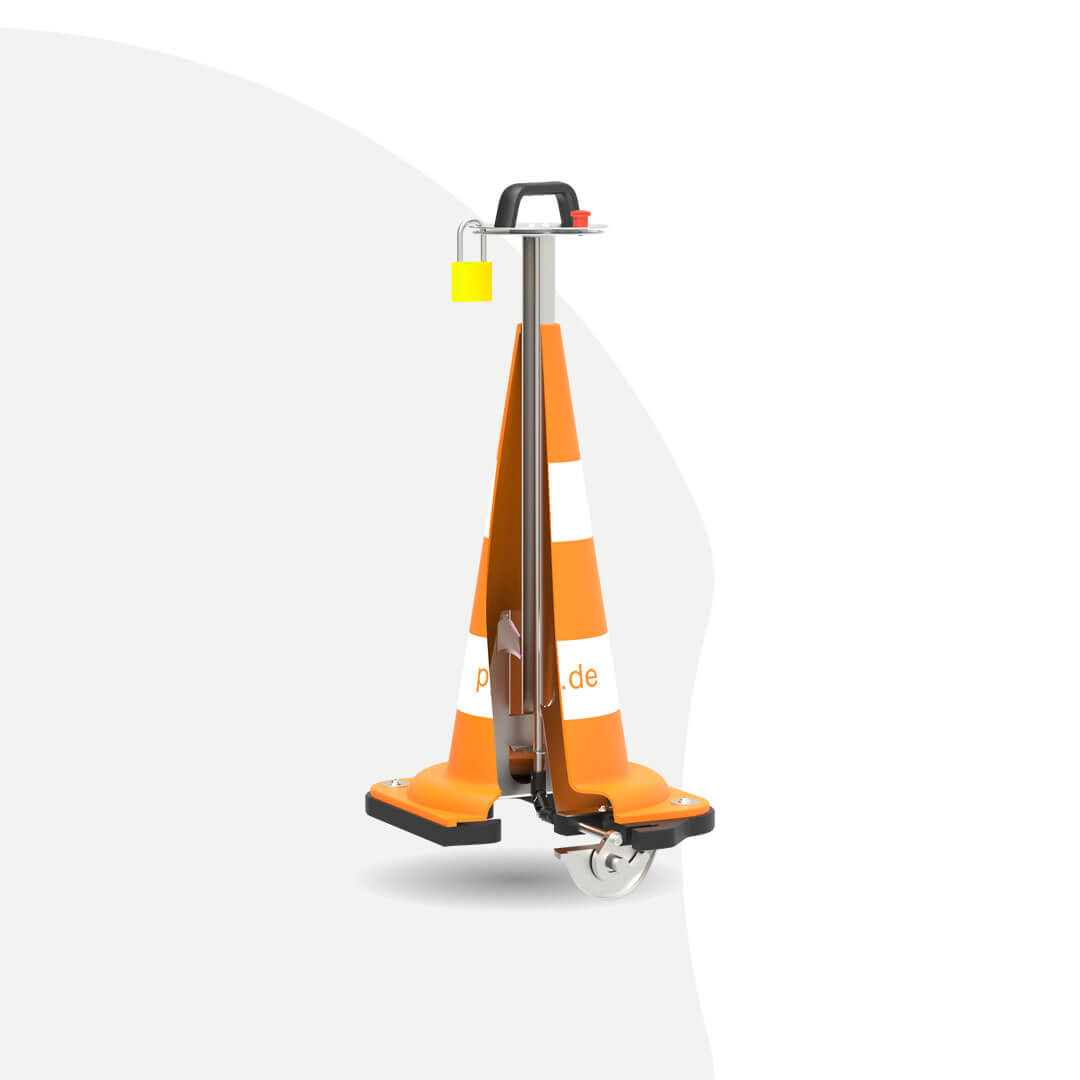
Why Pyloto?
Pyloto helps you to minimize risks within automated guided vehicle systems and protect your employees.
Automated guided vehicle systems fulfil very high safety standards without excluding residual risks.
These risks exist depending on the environmental conditions and the work tasks the employees perform in the operating zone of the automated guided vehicle.
Significant risks exist in particular during maintenance work at interfaces to infrastructure and peripheral facilities where non-detection of persons or objects can result in serious harm.
For a safe stop of automated guided vehicles electro-sensitive equipment is installed. According to ISO 3691-4:2020 it must be executed with performance level D.
Certain areas of the automated guided vehicle system are mostly not covered by suitable personnel detection means:
The automated guided vehicle can NOT detect persons
- on load transfer stations such as conveyors or racks
- on interfaces between machines
- in high racks
- in block storages or very narrow aisles
- in lifting work baskets
- on elevating work platforms
- on ladders
Certain objects are not covered by suitable electro-sensitive protective equipment:
The automated guided vehicle can NOT detect persons
- very narrow objects
- very flat objects
- hanging objects
In these cases the protection of the working areas with Pyloto is indispensable in order to avoid personal injury.
Protect your Employees
Pyloto helps you to protect your employees in an easy and reliable way by consequently following the lockout-tagout procedure.
With our blocking device Pyloto areas within the automated guided vehicle system can be reliably blocked for example during maintenance work.
Pyloto allows the usual and solid lockout-tagout procedure whereby every person involved locks the cone with a personal padlock.
Our blocking device Pyloto uses the performance level of the electro-sensitive protective equipment that is installed in the automated guided vehicle. In this way the reliable stop of the automated guided vehicle is ensured.
Blocking areas through the radio link of the guidance control system does not comply with the required performance level D and is not secured against accidental or unauthorized restart.
Setup
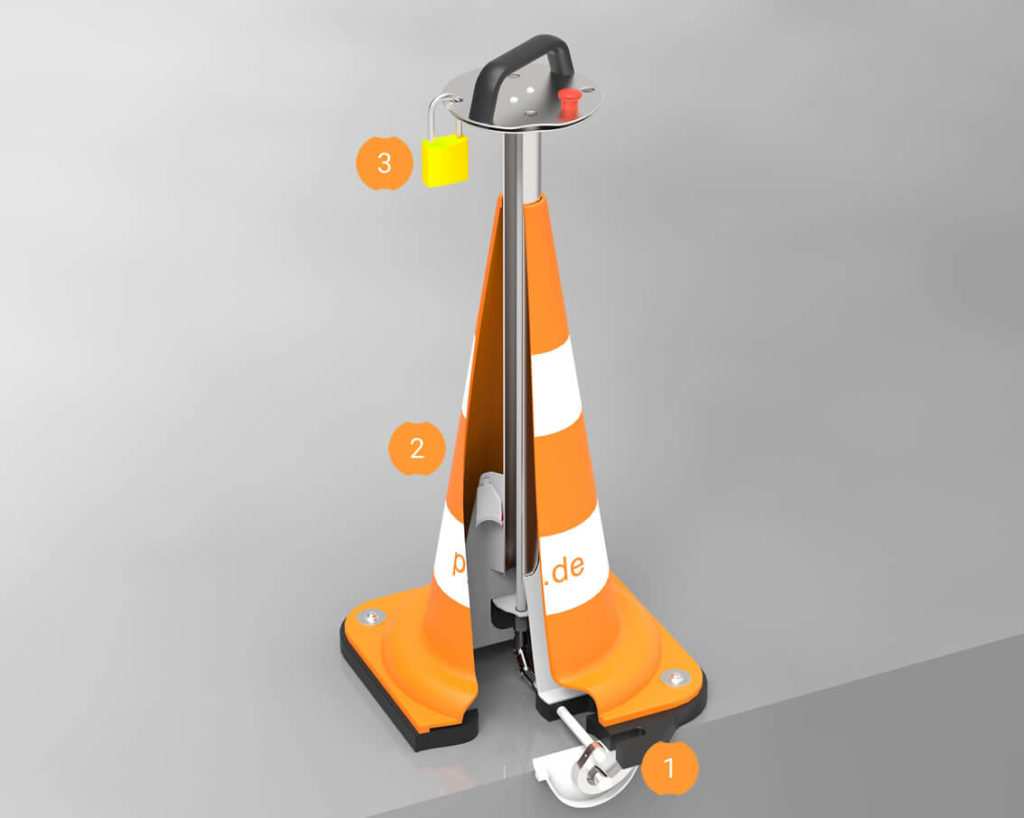
General view
- ground insert Pyloto-Pin
- blocking device Pyloto-500
- personal padlock
- ground insert Pyloto-Pin
- blocking device Pyloto-500
- personal padlock
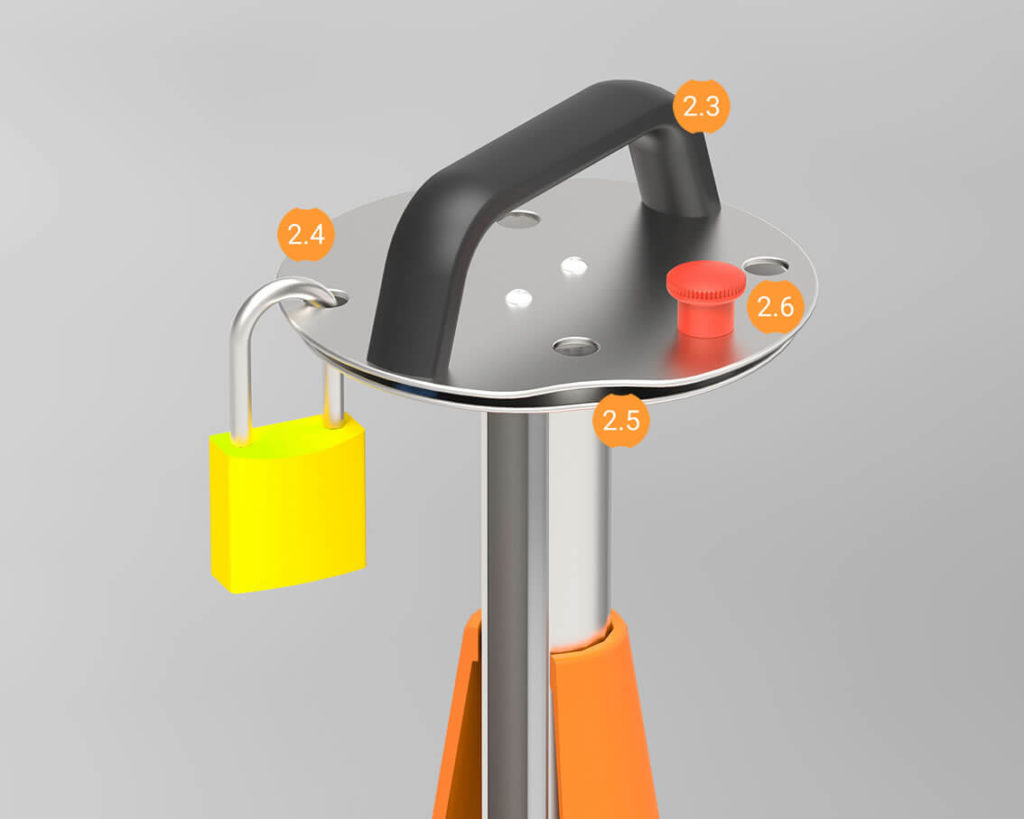
Details Top
- handle
- rotary plate
- fixed plate
- Locking bolt
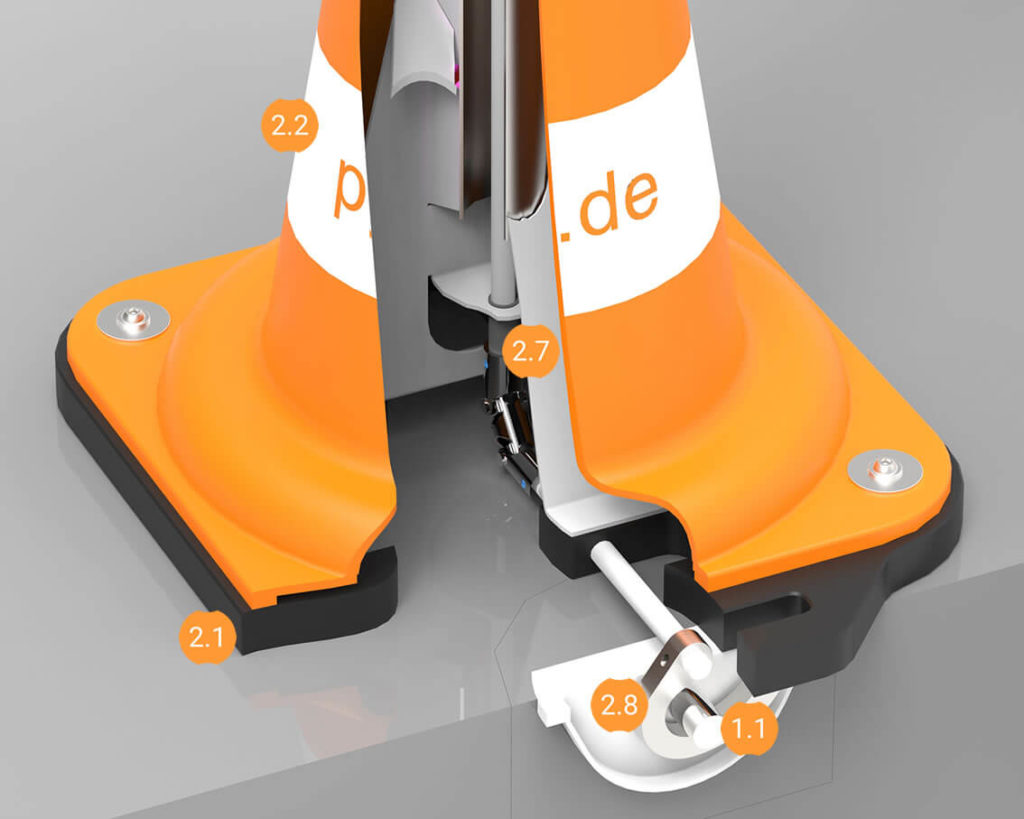
Details Bottom
- pin
- Baseplate
- pylon
- Double universal joint
- Locking hook
Operation
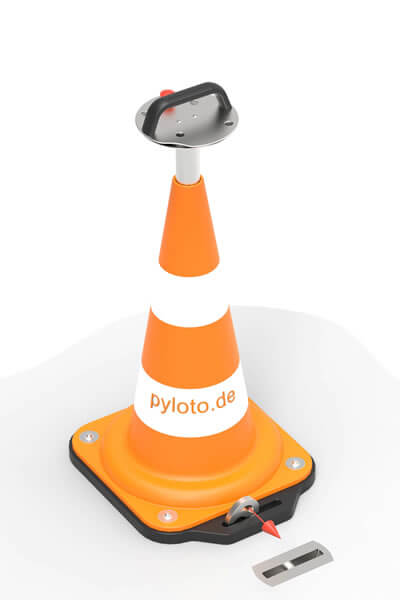
Step 1
Push the locking hook of the blocking device Pyloto-500 over the pin of the ground insert Pyloto-pin.

Step 2
Pull the indexing plunger upwards and thus unlock the rotation.

Step 3
Rotate the handle clockwise until the padlock holes align.
In this position the indexing plunger locks again and blocks the rotation.

Step 4
Lock the blocking device Pyloto-500 with your personal padlock.

Step 1
Push the locking hook of the blocking device Pyloto-500 over the pin of the ground insert Pyloto-pin.

Step 2
Pull the indexing plunger upwards and thus unlock the rotation.

Step 3
Rotate the handle clockwise until the padlock holes align.
In this position the indexing plunger locks again and blocks the rotation.

Step 4
Lock the blocking device Pyloto-500 with your personal padlock.
Technical Data
blocking device Pyloto-500
ground insert Pyloto-Pin
FAQ
Why is Pyloto not a lockable cone?
Pyloto is used to initiate a protective stop of an automated guided vehicle and is not suitable for traffic guidance.
Does Pyloto enable maintenance assurance within automated guided vehicles?
Pyloto allows the usual and solid lockout-tagout procedure whereby every person involved locks the cone with a personal padlock.
Can Pyloto be used for driverless industrial trucks within automated guided vehicles?
Pyloto can be used within driverless truck systems wherein driverless industrial trucks are equipped with electro-sensitive protective equipment. Pyloto is not suitable for driverless industrial trucks with pressure-sensitive protective devices.
Is Pyloto a lockable blocking device or a lockable blocking utensil for automated guided vehicles?
Yes, Pyloto allows blocking certain areas within automated guided vehicle systems that are not covered by suitable personnel detection means. Furthermore Pyloto is lockable what allows the solid and usual lockout-tagout procedure.
Why should Pyloto not be used as a lockable traffic cone?
Pyloto is not suitable for traffic guidance because in case of this misuse material damage to vehicles and Pyloto is expected.
Why is a lockable blocking pylon necessary?
Certain areas of automated guided vehicle systems are not covered by suitable personnel detection means. In these cases the protection of the working areas with Pyloto is indispensable in order to avoid personal injury.
Is Pyloto the name for a LOTO pylon or a lockout-tagout pylon?
Pyloto results of pylon and LOTO. Pyloto can also be named LOTO pylon and allows a consequent lockout-tagout procedure within automated guided vehicle systems.
Is Pyloto the name for a LOTO pylon or a lockout-tagout pylon?
Pyloto results of pylon and LOTO. Pyloto can also be named LOTO pylon and allows a consequent lockout-tagout procedure within automated guided vehicle systems.
Is Pyloto the name for a LOTO pylon or a lockout-tagout pylon?
Pyloto results of pylon and LOTO. Pyloto can also be named LOTO pylon and allows a consequent lockout-tagout procedure within automated guided vehicle systems.
Is Pyloto a lockout device?
Pyloto is a lockout device that allows blocking certain areas of automated guided vehicle systems that are not covered by suitable personnel detection means. Thereby every person involved locks the cone with a personal padlock.
FAQ
Why is Pyloto not a lockable cone?
Pyloto is used to initiate a protective stop of an automated guided vehicle and is not suitable for traffic guidance.
Does Pyloto enable maintenance assurance within automated guided vehicles?
Pyloto allows the usual and solid lockout-tagout procedure whereby every person involved locks the cone with a personal padlock.
Can Pyloto be used for driverless industrial trucks within automated guided vehicles?
Pyloto can be used within driverless truck systems wherein driverless industrial trucks are equipped with electro-sensitive protective equipment. Pyloto is not suitable for driverless industrial trucks with pressure-sensitive protective devices.
Is Pyloto a lockable blocking device or a lockable blocking utensil for automated guided vehicles?
Yes, Pyloto allows blocking certain areas within automated guided vehicle systems that are not covered by suitable personnel detection means. Furthermore Pyloto is lockable what allows the solid and usual lockout-tagout procedure.
Why should Pyloto not be used as a lockable traffic cone?
Pyloto is not suitable for traffic guidance because in case of this misuse material damage to vehicles and Pyloto is expected.
Why is a lockable blocking pylon necessary?
Certain areas of automated guided vehicle systems are not covered by suitable personnel detection means. In these cases the protection of the working areas with Pyloto is indispensable in order to avoid personal injury.
Is Pyloto the name for a LOTO pylon or a lockout-tagout pylon?
Pyloto results of pylon and LOTO. Pyloto can also be named LOTO pylon and allows a consequent lockout-tagout procedure within automated guided vehicle systems.
Is Pyloto a lockout device?
Pyloto is a lockout device that allows blocking certain areas of automated guided vehicle systems that are not covered by suitable personnel detection means. Thereby every person involved locks the cone with a personal padlock.